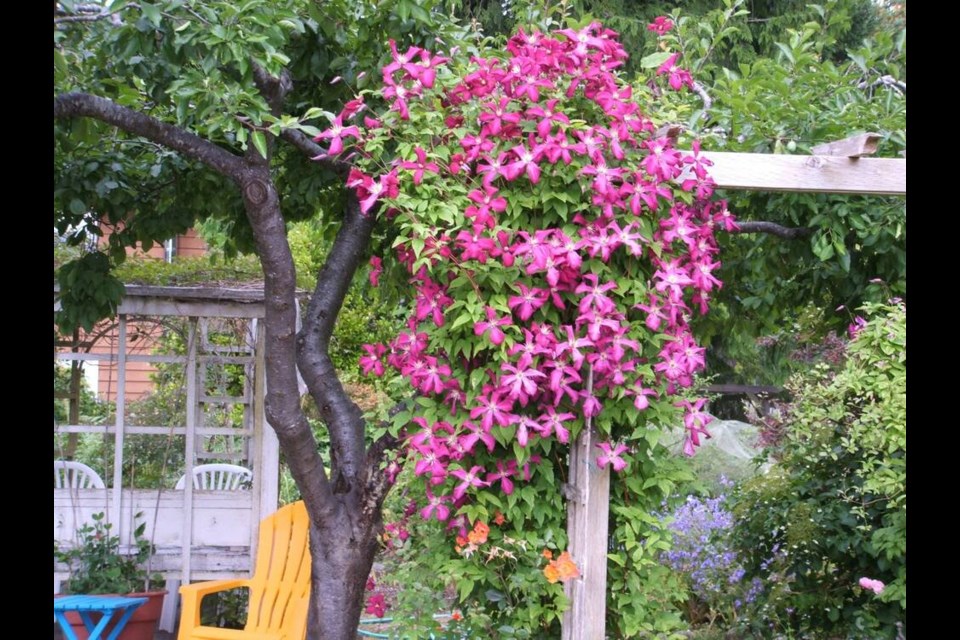Dear Helen: The garden we inherited in the spring, when we acquired our current home, has a plant I do not know how to deal with. It’s an old, unpruned clematis vine with newer, green growth tangled up with older and some dead stems. This clematis bears large, purple blooms beginning in June. I believe it is a commonly grown variety. Would it be safe to prune the vine severely, almost to the ground? I am also wondering about the best time to prune clematis.
C.R.
Dealing with the cultivation of different kinds of clematis is a common issue for home gardeners. Your clematis could very well be Jackmanii, the best known and probably most widely grown of all clematis varieties. Like other clematis vines that begin blooming in early summer, it flowers on the current year’s growth. If the vines are left unpruned, most new growth and flowering starts near where the previous year’s growth ended, sending the vine out of control with flowering only in the vine’s upper regions.
These summer bloomers, because the flowers grow on stems produced that same spring and early summer, are easy to prune. The idea is to get rid of most of the old growth to make way for the new. To get lots of new growth, and flowers low down on the vine, prune the plants back hard in late winter, cutting above the first or second lowest set of plump buds on each stem. On older plants, cut immediately above strong sets of buds 30 to 60 cm above the ground. As new stems grow, thin them out as needed to avoid overcrowding.
Not all clematis vines are pruned in the same way. Spring-flowering clematis, such as Clematis montana (anemone clematis), C. alpina (alpine virgin’s bower) and C. macropetala (downy clematis) bloom on growth produced in the previous year. They require little pruning except to restrict their size, reduce tangling and remove dead wood.
The framework of the vine is preserved, with the main stems shortened where necessary to fit the plant’s support and the side shoots shortened to relieve crowding. Prune after flowering. When these early bloomers become a tangle and you want to renew them, cut the stems back to good buds close to the ground in June. The new growth made in summer will yield the next spring’s flowers.
Dear Helen: Most of my beets and some of the carrots are protruding to varying degrees above soil level. Do they need some sort of protection against freezing?
R.L.
Beets, especially the cylindrical varieties, commonly protrude well above soil level and become vulnerable to damage in freezing weather. Carrots will do the same, but usually to a lesser degree.
To protect root crops from frost damage through the winter, and preserve these valuable foods in good useable condition, cover over the tops with an insulating mulch layer (or layers).
My preference is to add a layer of garden soil around and a little over the root tops before adding a layer of small, fluffy (or chopped) leaves over the soil. A loose covering of straw over the leaves can be helpful in times of hard freezing.
For ease of harvesting the root vegetables over the course of the winter, I mark the mulched plot with four corner stakes, moving the stakes as rows of the roots are removed.
Dear Helen: Are you familiar with shut-off valves used to connect hoses? The one we have allows us to turn off a sprinkler and move its position without having to return to the tap at the house. We hang the hoses up, still connected, for the winter. Should we leave the valve open or shut?
W.J.
Neither. According to the information that came with my brass shut-off valve, in temperatures below freezing the position of the on-off lever that prevents water from being trapped in the mechanism is at a 45-degree angle. Trapped water can freeze, expand, and crack the valve.
My shut-off valve joins hoses at the half-way mark between the house and back fence. In my 61-metre-deep garden, it’s been a significant saver of time and effort.
GARDEN EVENT
Open house and market. Dinter Nursery, 2205 Phipps Rd. in Duncan, is hosting its annual Christmas Open House. 9 a.m. to 5 p.m. on Saturday, with a Makers Market featuring local vendors, 10 a.m. to 3 p.m. Details at .



